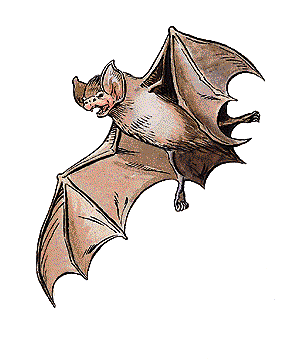Bat, Huge [584] 
| Climat/Terrain | Warm caves |

|
|
| Organisation | Flock | ||
| Fréquence | Rare | ||
| Diète | Omnivore | ||
| Cycle d'activité | Night | ||
| Intelligence | 5-7 - Intelligence basse | ||
| Trésor | C | ||
| Alignement | Neutre Mauvais | ||
| Nombres | 1-8 | ||
| Classe d'armure | 7 (see below) | ||
| Mouvement |
Au sol :
3'' Vol : 15 - Classe de vol : C Nage : Enfouissement : Web : |
||
| Dés de vie | 4-6 | ||
| Thac0 | 17 (4 HD) 15 (5-6 HD) | ||
| Nbre d'attaques | 1 | ||
| Dommage / attaques | 2-8 | ||
| Attaques spéciales | See below | ||
| Défenses spéciales | See below | ||
| Résistance à la magie | Nil | ||
| Taille |
H - huge ( 12+' to 25' ) (12-16’) |
||
| Morale | 15-16 - Champion | ||
| Valeur en XP |
420 xp (4 HD) 650 xp (5 HD) 975 xp (6 HD) |
||
| Commentaires :
Bats are common animals in many parts of the world. While ordinary bats are annoying but harmless, larger varieties can be quite deadly. With almost 2,000 different species of bats known, one can find wingspans from less than two inches across to 15 feet or more. The small body of the ordinary bat resembles a mouse, while the wings are formed from extra skin stretched across its fore limbs. The larger bats are scaled up but otherwise similar in appearance. Despite the common belief that bats are blind, nearly all known species have rather good eyesight. In the dark, however, they do not rely on their visual acuity, but navigate instead by echo-location. By emitting a high-pitched squeal and listening for it to bounce back to them, they can see their surroundings by this natural form of sonar. |
|||
| Combat : Ordinary bats attack only if cornered and left with no other option. If startled, bats tend to become frightened and confused. This causes them to swarm around and often fly into things. The typical bat swarm ends up putting out torches (1% chance per bat encountered per round), confusing spell casting (Wisdom roll required to cast spells), inhibiting combatants’ ability to wield weapons (by a -2 THAC0 penalty), and otherwise getting in the way. Under ideal flying conditions, a bat’s Armor Class rating rises from 8 to 4. | |||
| Habitat / Société : While bats are found almost anywhere, they prefer warm and humid climes. Some species hibernate during the cold season and a few are know to migrate. Bats live in caves, dark buildings, or damp crevices, hanging by their toes during the day, and leaving at dusk to feed during the night. In large, isolated caverns there may be thousands of bats. | |||
| Ecologie :
Most bats eat fruit or insects, though some include small animals or fish in their diets. The rare vampire bat travels at night to drink the warm blood of living mammals, but its victims are rarely humans or demihumans. Care must be taken not to confuse the vampire bat with the true vampire in this regard. Rot grubs and carrion crawlers are among the few creatures known to live in the guano on the floor of large bat-infested caverns, making any expeditions into such caves dangerous indeed. If the noxious odor from the guano is not enough to subdue the hardiest of adventurers (a single Constitution check to stay conscious), these crawling denizens are. Huge Bat (Mobat) Mobats prefer warm-blooded prey that they bite to death with their fangs. They have a dim and evil intelligence that gives them a desire for shiny objects. Because the typical mobat has a wingspan of 12 to 16 feet, they must have large areas to serve as flight runways. Because Mobats’ flight is so rapid and silent, their victims suffer a -3 penalty to their surprise rolls. They can also give a piercing screech that causes such great pain that victims seek to cover their ears rather than fight, unless a saving throw versus paralyzation is successful. This screech is always used if the prey resists and it is effective in a 20-foot radius about the mobat. Note that mobile mobats have an Armor Class of 2. Under crowded flying conditions, their Armor Class suffers and raises to 7. When not in flight, mobats have an Armor Class of 10. |